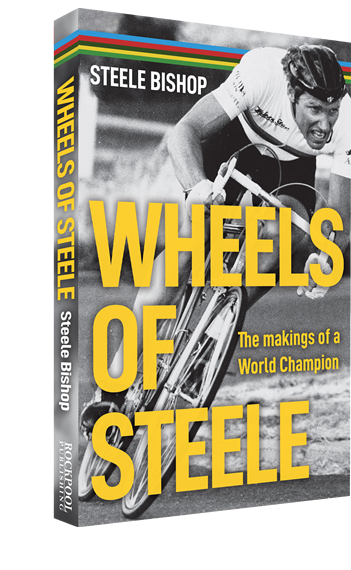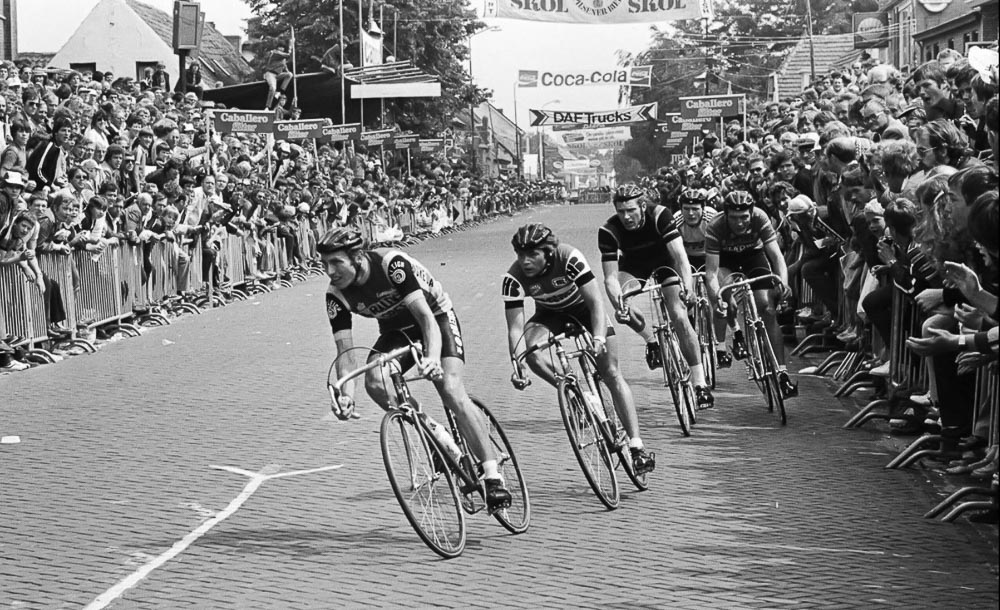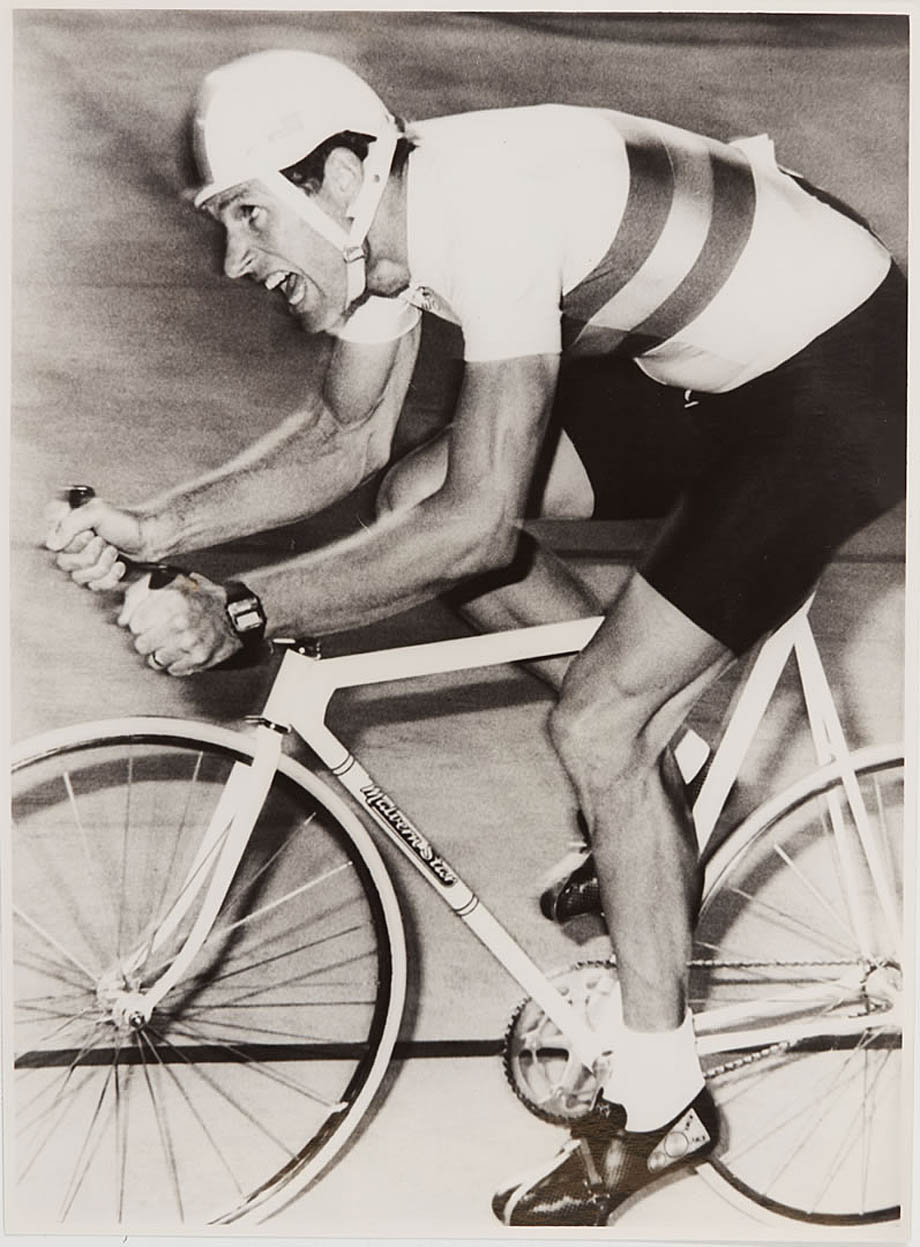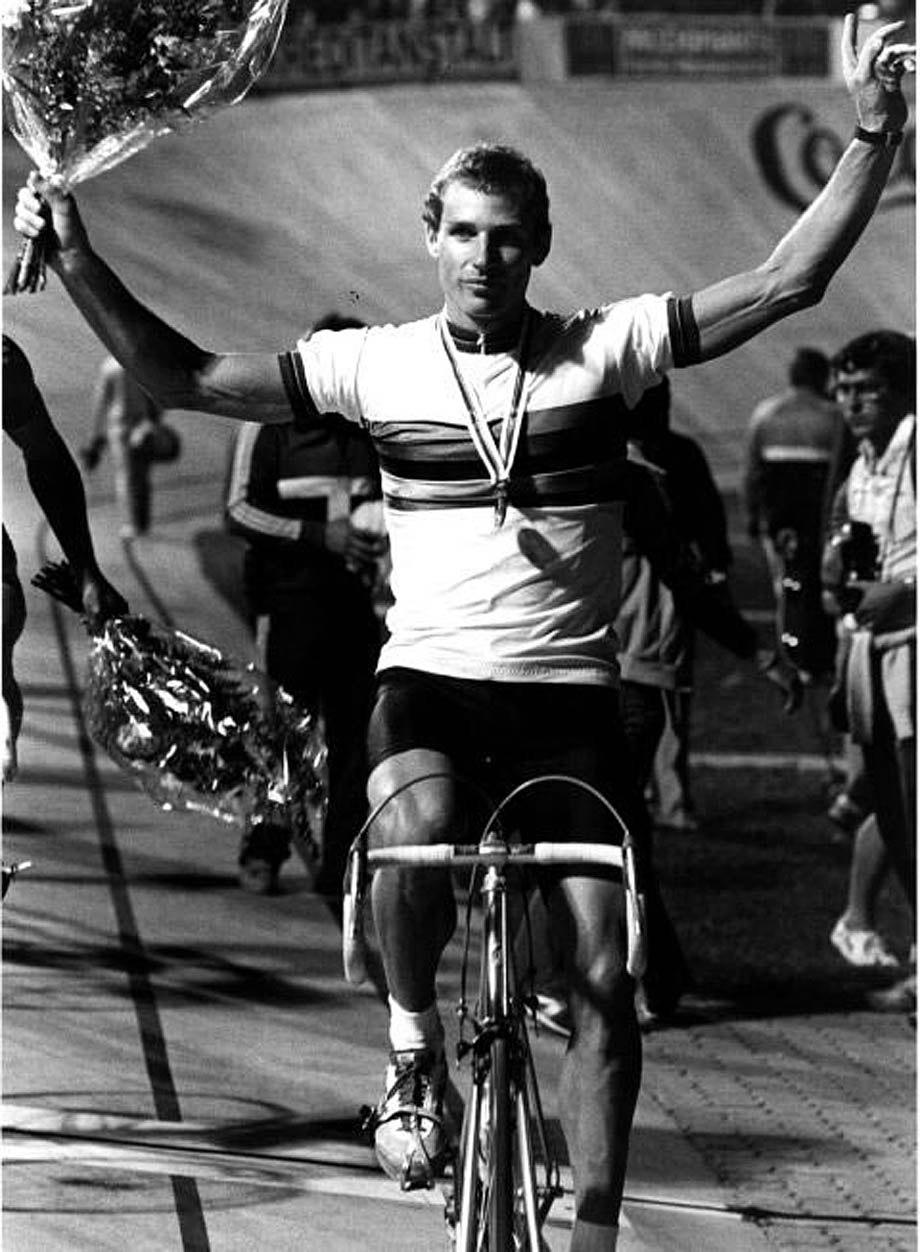
I was fortunate enough to get an interview with Steele Bishop at which time he told me he was writing a book about his career: “Steele Bishop, Wheels of Steel“.
The book takes us from his first tentative rides right up to the current day – he’ll be in Manchester for the Masters Worlds in October – by way of his amateur and pro careers and goes into the fascinating ‘small print’ of his three big bids for the Worlds, culminating in his Zurich success.
When I were a lad, if I’d asked any of my club mates who the World Professional Pursuit Champion was I’d have got the answer back in an instant.
The 5,000 metre pro pursuit rainbow jersey was a big deal; if the World Professional Road Champion wasn’t present at a pro road race or Criterium and the Professional World Pursuit Champion was there then he was obliged to wear his rainbow jersey.
For me, the ’60’s through to the ’80’s were the discipline’s golden era, since it went ‘open’ on 1993 and down to 4,000 metres it hasn’t aroused the same interest, not unless there’s a Boardman or an Obree to pique the UK interest.
But ‘back in the day’ stars like: Faggin, Bracke, Porter, Schuiten, Braun, Oosterbosch, Bondue, Doyle, Orsted, Moser were names we were all familiar with. Either big, lean greyhound specialist pursuiter/chronomen; many of whom who used their rainbow jerseys as big bucks calling cards into the Six Days or ‘Bigs’ like Moser who could do it all.

But tucked between specialists Alain Bondue in Leicester ’82 and Hans Henrik Orsted in Barcelona ’84 was an ‘outsider’ named Steele Bishop who won in Zurich in ’83.
Bishop was a fireman back in Oz and not part of the EuroPro circus, brought up in a climate of handicap racing on road and track which bred hard men with big finishes.
When I saw him win in ’83 I had a, “who’s this guy moment” but then I remembered I was there when he put out home favourite, big Sean Yates in the rain-hampered Leicester Worlds in ’82 before going out to Dane Orsted – surely one of the greatest pursuiters to put a leg over a superlight bike; the Dane mounted the pro pursuit podium for eight years straight with three gold, three silver and two bronze medals.
What I’d also ignored was that he’d ridden strongly but gone out to eventual bronze medallist that year – 1981 – to the late Big Bert Oosterbosch in Brno where stylish Alain Bondue of France picked up the first of his two rainbow jerseys.

Bishop was also a hugely experienced track man, having gone from school kid to professional riding on just about every kind of oval one could imagine in the Tasmanian Christmas and new Year carnivals and had ridden The Munich Olympics and Worlds as well as a spell of riding the insanely fast Dutch criteriums.
It was far from a ‘seamless’ progression and there are twists and turns all along the way, not least that he quit the sport twice; the first time, disillusioned with the Australian amateur milieu and was tempted back in by those who could see his ability and offered him a pro contract so his talent would not go to waste.
The second time the decision came after his Leicester Worlds adventure and shortly before he was awarded the ‘Oppy Oscar’ – officially known as the ‘Sir Hubert Opperman Trophy’ for the best Australian Cyclist of the year.
The prize?
Return air tickets to Zurich for the Worlds.
It was a ‘sign’ and his meticulous preparation for the 5,000 metre professional championship of the world began all over again.

When one reads of the hard work Bishop did then you realise that your own ‘training’ would barely register with a man like him.
Here’s a typical day on his lead in to his successful Worlds:
- a two hour warm upon the road before arriving at the track
- two hours of starts
- two kilometre standing and flying start time trials
- 30 minute ride back to the hotel, shower, eat, relax then back to the velodrome in the car for two hours of speed work behind the motorbike.
The man did not do things by halves.
And in the days before ‘marginal gains’ were even thought about he realised the importance of nothing being left to chance, assembling a team around him to leave no stone unturned in his build up to Worlds.
- chiropractor
- fitness and mental coach/dietician
- cycling coach
- mechanic/training partner
- travel co-ordinator and general support
- masseuse
As one would expect, his attention to his bike was at a similar level of meticulous attention to detail and he was one of the first to adopt a ‘funny’ – what we now call ‘low profile’ machine.
The frame was made in Switzerland by revered builder Leo Estermann who had been building frames since before the war and who built frames for Swiss legends Hugo Koblet and Ferdi Kubler.
Swiss Olympic 4,000 Metre Pursuit Champion Robert Dill Bundi was another who rode the famous marque and Bishop decided that he wanted one too – only the best would do.
The price in 1981 was 1,500 Australian Dollars, a heck of a lot of dough for a bike frame in those days.

As well as his pursuit qualities – he was either silver or gold medallist in the Australian pro pursuit championships for 10 years straight from 1975 until 1984 – he also won the pro national championships in the 50 kilometre points race, 10 kilometre scratch and 2,000 metre keirin.
He was also a ‘Wheelrace’ demon – these are handicaps where riders of all abilities go through heats to reach the final with the ‘scratch’ men giving away big distances to the ‘limit’ men.
They’re hotly contested, well supported and carry good purses.
Bishop won the historic – first held in 1897 – 3,000 metre Westral Wheelrace six times and on every occasion it was from scratch, with the last win of his pro career being the 1984 Westral.
He also won the prestigious Austral Wheelrace – which is even older, dating from 1887 – from scratch in 1982, an event which the likes of Gordon Johnson, Danny Clark, Gary Neiwand and Shane Perkins have all won.

I say the last race of his pro career because he’s back in action winning gold in the Australian Masters Champs in the 500 metre TT, points and 2,000 metre pursuit [naturally] as well as silver in the sprint and bronze in the scratch.
And the bikes?
An Argon 18 as ridden by the Aussie and Danish team pursuit squads – you’d expect nothing less.
An inspiring read and made all the better by his ‘tips for success’ as an appendix.



